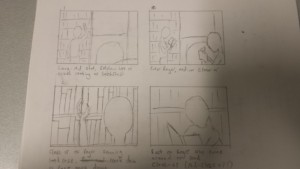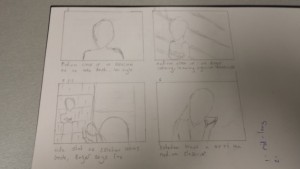The “Scene in Cinema” studio has been surprising, engaging and inspiring. I had very little idea about what I could expect from the class, my only hint being a short paragraph, describing it as an in depth look into the construction of a scene. I had assumed that we would be looking at scenes from a theoretical stand-point, without any practical work. How wrong I was, first class had us group up and set out to shoot a single take scene given to us from a small vague prompt. This first class really foreshadowed what the rest of the semester would be like, even though the outline for the studio was exploratory and prone to change. For the early part of the semester, we would tackle these exercises with varying constraints and aims, before, in the latter half, given the initiative to set out on our own (dramatically speaking) to incorporate our knowledge and experience to produce scenes of our own.
This method of learning was, and still is, very exciting to me. As I am in my third year of university, I am anxious about what comes after. My dream job is to direct feature films, and this studio struck me as a crash course in the fundamentals of quality shot construction. Furthermore, the entire studio experience felt very collaborative. More than simply working together on exercises, each of us were given the opportunity to contribute our individual ideas or anxieties to the class, through class discussion, an in-class presentation, as well as having access to one another’s blogs. These ideas didn’t need to be consistent with one another to be inspiring. For instance, Mia came up with a fantastic idea of experimenting with directorial methods of established directors such as Nicholas Winding Refn and Alfred Hitchcock. Rein’s style was particularly interesting to me, as I love his heavily stylised films, in how he shoots chronologically with very little storyboarding. While I like the security and clarity a storyboard affords, I also like to work in a spontaneous way. In contrast, Jason had the idea of exploring realism in cinema by working off a prompt, with little to no script or storyboards. This, as a creative and experimental method, was inspiring. Completely abandoning structured production in favour of obtaining an organic and immediate performance reinforced, for me, the idea that there is no one way to create film.
Through analysing scenes by filmmakers I admire, and working on specific elements of filmmaking, I developed a clearer understanding and vision as to how I work, how I would like to improve, and what kind of style(s) I would like to portray in my work. Moreover, through class discussion, I obtained a broader view of aesthetic styles and practices that would not have come to my attention otherwise. I have started a list, which grows faster than I can keep up, of films and directors I would like to watch or have been recommended to me by others. I often reflect that I do not expose myself to enough material outside of my immediate interest, so this is a good exercise for me to keep up throughout the rest of my life.
Unfortunately, unless I am working on something personal which I intend to make available for others to see (and judge), I tend to lack the motivation which was required of us this semester. I found maintaining a steady work ethic hard, procrastinating and also simply forgetting to keep up with my written reflection and analysis. This is a major shortcoming on my behalf and is not to say that I did not value the exercise. Reflection in one form or another is necessary in any profession, and having the blog as a visual historical reference of my thinking process has been as beneficial as the act of writing itself. Furthermore, the practical work of doing independent exercises has brought to light what I am good at and what I still lack. I feel as though I am am efficient director, who generally has a clear vision which I can generally obtain to some degree. I have acting experience and this helps me articulate my vision to the actors. Yet as I said, I can be lazy and complacent, and need to become better at networking and working with others if I want to be successful and produce quality work.
In the final part of the semester, we were asked to refine the ideas and aims we projected in a proposals. I had spoken on film coverage in production and post, and the relationship between the two. This was to general however, and to me just sounded like “how do you shoot and edit?” After a time, and a few independent exercises, I refined my aim to investigate the question: “How does coverage captured during filming influence coverage through editing? How do these different stages influence and dictate style?” I do not think that I have obtained the answer to this question, rather, I think that this is going to be a question I should reflect on for as long as I am making videos. In saying that, however, I have garnered some small semblance of understanding coverage and the post production process in terms of its practicality and influence on style. For instance, in one exercise I did everything in chronological order, and the shots I framed did not compliment a method in which I cover the scene from every angle. In contrast, in my second independent exercise, I shot an excessive amount of footage, covering the action and dialogue from a variety of different angles with different camera movement. In the end I axed the majority of footage in favour for simpler coverage, however the exercise emphasised the idea that more coverage obtained by the camera allows for a more creative post-production process.
Post “Scene in Cinema”, and post university, I intend to continue making video’s, as my ultimate goal is directing. I have given myself a vague outline of progression that this course, as well as other units such as TV 1 and 2, has helped me formulate. Immediately after graduating (or even before, I still need to work some things out,) I intend to make a short film (4-7 mins) and submit it to a variety of film festivals. Should I fail to be accepted, I will continue to make shorts with this time constraint until I get one accepted and screened. Once this happens, I intend to progressively increase the length of these films incrementally, only increasing should one get accepted. Following this trend, I will accumulate a solid show reel, excellent experience, a more confident and consistent style and hopefully identify and harness a group of people who I work well with.


